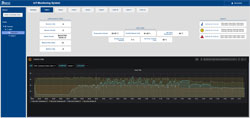 It is increasingly important nowadays to keep abreast of changes and be ready to face new challenges. From this perspective, it is essential that some processes could be changed or, to be precise, go through a real evolution not only in the technological field but also from the organizational and strategic point of view.
It is increasingly important nowadays to keep abreast of changes and be ready to face new challenges. From this perspective, it is essential that some processes could be changed or, to be precise, go through a real evolution not only in the technological field but also from the organizational and strategic point of view.
This is the case of the teleservice, that, today, is more and more going toward a process that we could call “virtualization”. But let us talk about it step by step. “Teleservice, that is the method of remote technical assistance, is a system that we have already successfully employed in Storci”, says Mr Luigi Zardi, Storci’s Electronic Department Manager “especially in all those situations when on site assistance service was not possible whatever the reason”.
This necessity has become unavoidable due to Covid19, consequently, the teleservice that we were used to, has inevitably moved to another level. Thanks to a system based on a specific cloud, Storci can implement - upon specific request of the Customer – a significantly more efficient database that allows to detect real time a series of data related to the line, about the drying phase and all the other details of pasta production process.
These data are remotely analysed and processed by a control room, thus stored in a system that is always updated and can be accessed totally and continuously. Machine data are sent in real time to a cloud where a database manager collects them for the historical data visualization. These data are periodically sent to our internal server for the long-term storage. Basically, this system finds an answer to the problem without being on site and, often, without bothering the Customer who can appreciate its solution with no intervention whatsoever.
 This is the Internet of Things, as the saying goes today. In this specific case, it means that the various components of the line become smart objects communicating to each other with a series of data and acquiring an active role thanksto the net that creates a link with an identification and localization process, able to develop information and interact with the rest of the system. The advantages of this system just leap out: reduction of travel expenses and manpower costs, assessment times streamlining, problem solving much sooner than standard Customer service. “In Spring 2020, during the lockdown, we remotely carried out the commissioning of a line” in conclusion Zardi says “and we trust that this practice, born in a moment of need, can become the standard, or, at least can be possible in most of the cases, with considerable advantages for everyone”.
This is the Internet of Things, as the saying goes today. In this specific case, it means that the various components of the line become smart objects communicating to each other with a series of data and acquiring an active role thanksto the net that creates a link with an identification and localization process, able to develop information and interact with the rest of the system. The advantages of this system just leap out: reduction of travel expenses and manpower costs, assessment times streamlining, problem solving much sooner than standard Customer service. “In Spring 2020, during the lockdown, we remotely carried out the commissioning of a line” in conclusion Zardi says “and we trust that this practice, born in a moment of need, can become the standard, or, at least can be possible in most of the cases, with considerable advantages for everyone”.